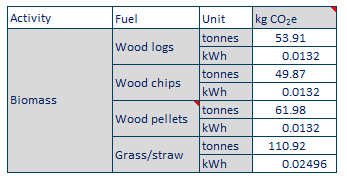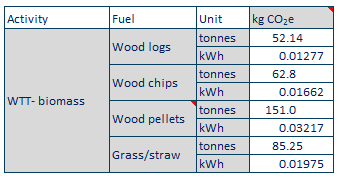First time here? Check out the Help page!
 | 1 | initial version |
Using OtherFuel1 is how I've done it in the past. I was only concerned with energy so didn't look at setting fuel factors.
What values you use will depend on what you're using it for. @JasonGlazer has already answered with an EPA source so I'll give an answer relecting research/business reporting in a UK context using the Defra emissions factors for company reporting which are available from here.
Scope 1 emissions are those produced by burning fuels. In this methodology, biomass CO$_2$ emissions are considered to be reabsorbed by new growth so the GHG potential from that CO$_2$ is set to zero. The scope 1 GHG emissions are therefore only those from N$_2$O and CH$_4$ produced during combustion which are not considered to be reabsorbed.

Scope 1 (product of combustion) GHG emissions from biomass
Scope 2 emissions are from electricity used directly in the organisation so not relevant here.
Scope 3 emissions are upstream emissions - the embodied carbon of producing and delivering the fuel. This would include agricultural emissions from growing the trees and fuel used in delivering the biomass to the building.

Scope 3 (upstream) GHG emissions from biomass
Out of scope For completeness, although the direct CO$_2$ emissions from burning the biomass are considered to be out of scope for the purposes of calculating a carbon footprint, there are some figures provided for this as out-of-scope emissions. The factors recommended are in this table.

Out of scope (expected to be reabsorbed) GHG emissions from biomass
 | 2 | No.2 Revision |
Using OtherFuel1 is how I've done it in the past. I was only concerned with energy so didn't look at setting fuel factors.
What factors. Given that you're also not particularly interested in the emissions, you can safely ignore the FuelFactor as all it does is feed into the report generated when you request Output:EnvironmentalImpactFactors. It has no effect on the energy model.
If you were interested in GHG emissions, say for predicting a carbon footprint, the values you use will depend on what you're using it for. @JasonGlazer has already answered with an EPA source so I'll give an answer relecting reflecting research/business reporting in a UK context using the Defra emissions factors for company reporting which are available from here.
Scope 1 emissions are those produced by burning fuels. In this methodology, biomass CO$_2$ emissions are considered to be reabsorbed by new growth so the GHG potential from that CO$_2$ is set to zero. The scope 1 GHG emissions are therefore only those from N$_2$O and CH$_4$ produced during combustion which are not considered to be reabsorbed.

Scope 1 (product of combustion) GHG emissions from biomass
Scope 2 emissions are from electricity used directly in the organisation so not relevant here.
Scope 3 emissions are upstream emissions - the embodied carbon of producing and delivering the fuel. This would include agricultural emissions from growing the trees and fuel used in delivering the biomass to the building.

Scope 3 (upstream) GHG emissions from biomass
Out of scope For completeness, although the direct CO$_2$ emissions from burning the biomass are considered to be out of scope for the purposes of calculating a carbon footprint, there are some figures provided for this as out-of-scope emissions. The factors recommended are in this table.

Out of scope (expected to be reabsorbed) GHG emissions from biomass
 | 3 | No.3 Revision |
Using OtherFuel1 is how I've done it in the past. I was only concerned with energy so didn't look at setting fuel factors. Given that you're also not particularly interested in the emissions, you can safely ignore the FuelFactor as all it does is feed into the report generated when you request reports, Output:EnvironmentalImpactFactorsAnnualBuildingUtilityPerformanceSummary - Site and Source Energy table, EnvironmentalImpactFactors, and SourceEnergyEndUseComponentsSummary. It has no effect on the energy model.
If you were interested in GHG emissions, say for predicting a carbon footprint, the values you use will depend on what you're using it for. @JasonGlazer has already answered with an EPA source so I'll give an answer reflecting research/business reporting in a UK context using the Defra emissions factors for company reporting which are available from here.
Scope 1 emissions are those produced by burning fuels. In this methodology, biomass CO$_2$ emissions are considered to be reabsorbed by new growth so the GHG potential from that CO$_2$ is set to zero. The scope 1 GHG emissions are therefore only those from N$_2$O and CH$_4$ produced during combustion which are not considered to be reabsorbed.

Scope 1 (product of combustion) GHG emissions from biomass
Scope 2 emissions are from electricity used directly in the organisation so not relevant here.
Scope 3 emissions are upstream emissions - the embodied carbon of producing and delivering the fuel. This would include agricultural emissions from growing the trees and fuel used in delivering the biomass to the building.

Scope 3 (upstream) GHG emissions from biomass
Out of scope For completeness, although the direct CO$_2$ emissions from burning the biomass are considered to be out of scope for the purposes of calculating a carbon footprint, there are some figures provided for this as out-of-scope emissions. The factors recommended are in this table.

Out of scope (expected to be reabsorbed) GHG emissions from biomass
